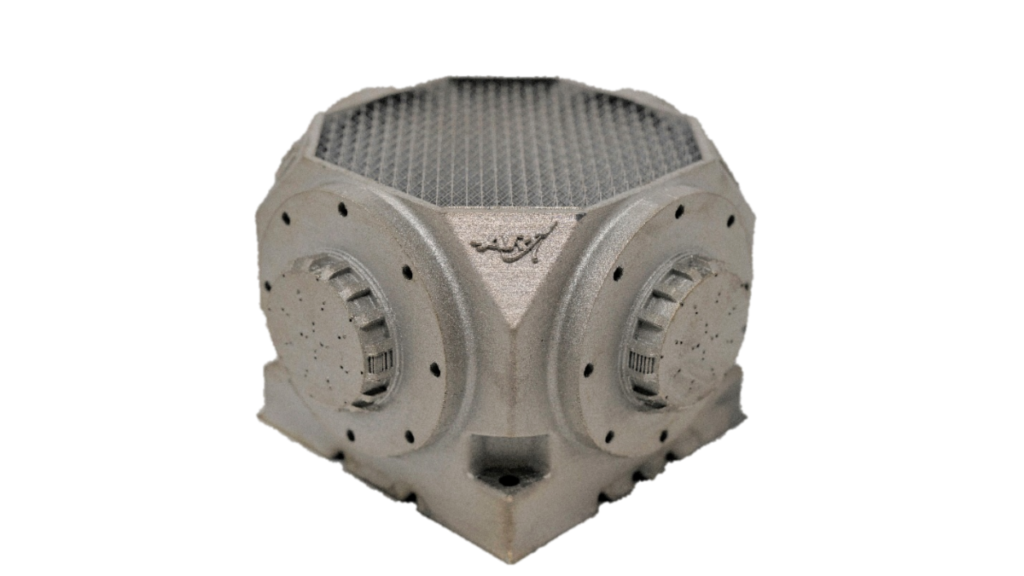As NASA pushes forward on at its Artemis missions to return to the moon, Aerojet Rocketdyne turned to VELO3D and nTolpology to redesign a 60 year old manifold for a thruster for the project. Using additive manufacturing (AM), the team hoped to drive down production costs and speed up development, all while improving the performance of the component.

“As with any complex endeavor, the more affordable you can make it, the greater the chance that you will ensure its completion, and the moon is no different. Metal AM plays a key role in achieving these goals,” said James Horton, mission architect at Aerojet Rocketdyne,.
The R4D component being resigned is a crucial part of a vehicle’s reaction control system (RCS), which manages the orientation of the craft. The RCS can be fired, usually briefly, in any direction, to change the direction of rotation of the craft. With this control, the vehicle can be directed up or down (pitch), laterally around its main axis (roll), or left or right (yaw). The R4D keeps the craft maneuverable, managing its direction and position.
Originally created for the Apollo missions, the element was redesigned with AM in mind to be more efficient. The Aerojet Rocketdyne team wanted to make the thrusters more reliable, reduce overall part count, make them easier to assemble and service, and, of course, reduce their weight.
James Horton added, “During the entire Apollo program, NASA produced more than 650 thrusters to support six Moon landings, It was a huge number, which led us to believe we were onto something big—we knew that, if we could bring affordability to the RCS, we could make a positive impact on any this and future programs.”
Typically, we can see that these goals are recurring in the commercial and governmental space markets. Weight reduces the launch costs of a component, while also allowing more kit to be placed on a craft, and possibly lengthening its range or capabilities.
Ease-of-assembly reduces costs considerably, especially since assembly times and schedules are often delayed or compressed, which could delay the mission. Assembly costs are additionally elevated because the work has to be performed by highly trained staff in cleanroom environments.
However, these costs pale in comparison to service costs. A spacewalk is an expensive endeavor and any time spent fixing this engine would at least interrupt and perhaps even render a mission useless. A reduction in part count makes it easier for a company to iterate new designs. It also means that a lot less tooling will have to be made. This significantly reduces the time to develop the craft and reduces costs as well. Fewer parts means fewer processes and process steps, as well as fewer interdependencies between parts and materials. As long as the 3D printing steps are well under control, it may be easier to reach OE targets. It does mean concentrating the risk more on 3D printing as a technology, but it could mean fewer unanticipated failures resulting from the interaction of solvents, fasteners, welds, glues, and other materials.

The Aerojet team turned to nTopology to redesign the part to save weight and reduce parts. On top of performing topology optimization, the team also wanted to optimize for 3D printing through reduction of the supports and support material needed. The optimized part contained lattices to save weight, while enhancing stiffness.
“We have a unique solution to mitigate accumulated internal stress within the printed material, and can avoid cracking more,” VELO3D Technical Sales Engineer Gene Miller said.
Printed in titanium on a VELO3D machine, the final part had a mass reduction of 50 percent at a third of the cost of a conventionally manufactured component. The RCS is currently being refined and they hope to get it on board future Artemis missions to the moon and beyond.
Subscribe to Our Email Newsletter
Stay up-to-date on all the latest news from the 3D printing industry and receive information and offers from third party vendors.
You May Also Like
Gorilla Sports GE’s First 3D Printed Titanium Cast
How do you help a gorilla with a broken arm? Sounds like the start of a bad joke a zookeeper might tell, but it’s an actual dilemma recently faced by...
Nylon 3D Printed Parts Made More Functional with Coatings & Colors
Parts 3D printed from polyamide (PA, Nylon) 12 using powder bed fusion (PBF) are a mainstay in the additive manufacturing (AM) industry. While post-finishing processes have improved the porosity of...
$25M to Back Sintavia’s Largest Expansion of Metal 3D Printing Capacity Since 2019
Sintavia, the digital manufacturing company specializing in mission-critical parts for strategic sectors, announced a $25 million investment to increase its production capacity, the largest expansion to its operations since 2019....
Velo3D Initiates Public Offering in a Bid to Strengthen Financial Foundations and Drive Future Growth
Velo3D (NYSE: VLD) has been among a number of publicly traded 3D printing firms that have attempted to weather the current macroeconomic climate. After posting a challenging financial report for 2023,...































